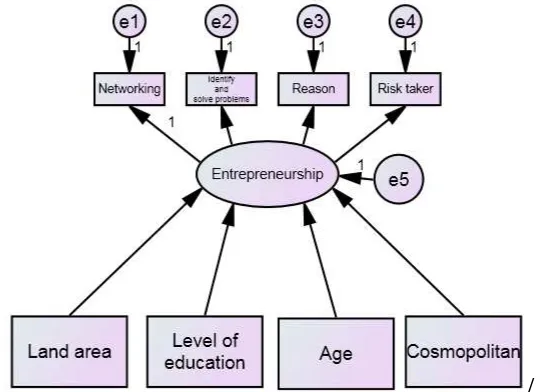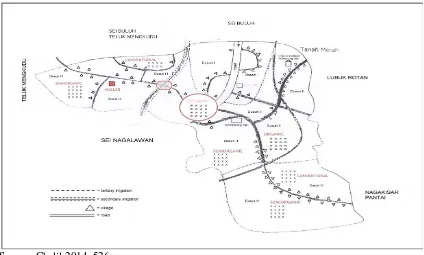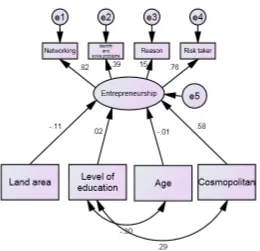ANALYZING ENTREPRENEURSHIP AMONG ORGANIC PADDY FARMERS income. However, this could only be realized if the farmers have the entrepreneurial ability to manage the dynamics of the organic rice agribusiness system. The aim of this study is to analyze the entrepreneurship among organic paddy farmers in North Sumatra. Data were collected from depth interview with 45 organic, semi organic and conventional paddy farmers, and analyzed with Structural Equation Model (SEM). The level of entrepreneurship is formed by 4 possible factors namely networking, the ability to identify and solve problems, reasons to become a paddy farmer and risk taking behavior. The factor loadings indicate that among them only networking and risk taking behavior appear to be important. Four possible variables namely land size, level of education, age and cosmopolitan level are included in the model. The estimation result shows that only cosmopolitan level significantly influences the entrepreneurial level.
Keywords: entrepreneurship, organic paddy farmers, networking, risk taking
Introduction
Rice is the staple food for the majority of Indonesians. With a population of 237 million, Indonesia is known as the world's largest rice consumer. As a strategic commodity, rice market in Indonesia is often interfered by the Government. However, this is not prevailed in the organic rice market. Therefore, organic rice producers could have the opportunity to gain potential profits that are likely to increase with the increase in consumer awareness of health and environment. Reviewing a number of empirical previous studies Siregar (2014) found that the majority of consumers are willing to pay premium prices for organic products. In the city of Morogoro, Tanzania, 78% of respondents are willing to pay premium prices because of the environmental and health benefits they receive by consuming organic products. In Kathmandu, 58% of the respondents are willing to pay 6%-20% more expensive for organic products, while in Indonesia consumers are willing to pay 65% more expensive than the actual organic products’ market price.
However, this potential extra benefit could only be realized if organic rice producers have the ability to manage the dynamics in the organic rice agribusiness system. In general, having the time lag between cultivation and maturation, and being perishable, agricultural commodity price fluctuations are relatively high. Moreover, the high dependency on uncontrollable factors such as climate and land suitability requires farmers to continuously make decisions not only based on the existing condition but also on the expectation and prediction of the future conditions Meridith et al. (1982 in Husin et al. (2012) state that entrepreneurs are characterized by their ability to predict the opportunities in the future. The organic rice market in Indonesia is still slowly developing. In North Sumatera, only 3 villages are recorded as organic paddy farming area. They are Desa Lubuk Bayas, Kabupaten Serdang Bedagai, Desa Namu Landor, Kabupaten Deli Serdang and Desa Laguboti, Kabupaten Toba Samosir, with an area of 21 ha, 2.5 ha and 20 ha, respectively (BITRA, 2013). Among them, Serdang Bedagai has the largest area, but only consists of 13 organic rice farmers.
1
Husin et al. (2012) show that in Malaysia, environmental considerations appear to be one of the entrepreneurial drivers in the agricultural sector. Farmers find that environmental friendly products, such as organic products give higher profit but with more challenges than non organic ones (Vonne et al., 2003). Moreover, the demand for environmentally friendly goods tends to keep increasing in the future (James and Stellingwerf, 2012). To analyze such a condition, this study was conducted to identify the characteristics of entrepreneurship among organic rice farmers in Sumatera Utara.
Method
This study is was conducted at Desa Lubuk Bayas, Kecamatan Perbaungan, Kabupaten Serdang Bedagai, which appear to be the largest organic paddy farming in North Sumatra. Data are collected through 13, 12 and 20 organic, semi organic and conventional farmers, respectively. Organic farmers are determined through census sampling method, while the semi organic and conventional farmers are determined with convenient sampling method. The data are then analized with Kruskal Wallis Test and Structural Equation Model (SEM). In the Kruskal Wallis Test, the data are divided into 3 groups namely the organic, semi organic and conventional farmers, while in the SEM estimation all of them are used to estimate a single model.
/
Figure 1. Indicators and Variables in the Structural Equation Model
values, which is the correlation of the variable and the factor. The square of the loading factor values are the interpreted as the contribution to the entrepreneurship level variance. Factor loading in between 0.3 and 0.4, 0.4 and 0.5 and greater than 0.5, which equals to a 9% and 16%, 16% and 25%, and greater than 25% variance, considers as minimum, more important and significant (Hair et al, 1998, p.111). Finally, difference in entrepreneurship level among farmers’ groups was analyzed with the Kruskal-Wallis Test.
To analyze the influencing factors for entrepreneurial characteristics, 4 independent variables namely (1) land area, (2) education, (3) age, and (4) the level of cosmopolitan were regressed to the dependent variable using the Structural Equation Model. Farmers' cosmopolitan level is measured with the frequencies of participating exhibitions, taking trips outside their village to search for information related with their business, or actively looking for the information in newspapers or televisions. The Goodness of Fit of the model is justified with the Values of Chi Square, CFI and RMSEA.
Results and Discussion
The results on the four independent variables influencing entrepreneurial characteristics are as follows. Concerning land space, on average farmers in Desa Lubuk Bayas own less than 1 ha of land area, with 0.54 ha, 0.71 ha, and 0.78 ha of the organic, semi-organic, and conventional ones, respectively. Many farmers only use a small part of their land area to cultivate organic rice for family consumption, as they realize organic rice is good for health, but consider that the risk is still too high while the benefit is still unclear. On education, all farmers have only finished their junior high school formal education. In general, farmers are still in the productive age with an average of 46 years. The development of organic rice in Lubuk Bayas is supported with a leader farmer, Mr. Kamaruddin’s entrepreneurship, who tries to make the organic rice farming as a profitable business. For example, Mr.Kamaruddin differentiates organic rice by applying different labels. By doing this, the rice can be sold with a higher price, with a range of Rp9.000,- to Rp15,000,- per kg (US$0.72 – US$1.2) In addition, Mr Kamaruddin also tries to provide organic pesticide, so that there is no constraint for the paddy farmers in Lubuk Bayas to apply the organic farming system. Loans for farmers to pay their previous chemical fertilizer usage and substitute to organic farming systems are also provided (Chalil, 2014).
The result shows that farmers’ entrepreneurial attitude level is still low, although that of the organic farmers is higher than the semi-organic and conventional farmers. In detail, 53.85% of organic rice farmers are within the moderate level, and 46.15% are within the low level of entrepreneurship. Semi-organic farmers have 50% each for the low and medium entrepreneurship levels, while all conventional farmers have low entrepreneurial level.
Kruskal-Wallis Test shows that the difference is significant at α 5%. The data shows that the main factor
that effects entrepreneurial attitude level among groups is the networking system. Organic farmers tend to be more active and have broader networking and are slightly more cosmopolite than the others, with total cosmopolitan scores of 6.80, 9.00 and 9.23 for the conventional, semi organic and organic farmers, respectively. The estimation indicates that organic farmers have higher score because they are more active in attending exhibitions.
conventional paddy farming (Figure 2). However, no organized and systematic effort has been taken in dealing with the problem.
Source: Chalil 2014, 526
Figure 2. Map of Lubuk Bayas Village
In addition, paddy farmers in Lubuk Bayas still have various misunderstandings about the organic rice farming system. Some farmers assume that in organic farming they can still use some chemical herbicides along with the organic fertilizers and pesticides as long as it is not directly applied to the paddy crop. Such a condition has often slipped through, as the surveillance system through Internal Control System (ICS) also needs to be improved.
Differently, Kruskal-Wallis Test shows no significant difference in the farmers’ ability to identify and solve problems, which is low for all groups. Some farmers cannot identify the causes, but even those who can identify were still unable to solve it. Organic farmers, for example, still have low productivity, although the 4 seasons of transition period has passed away. This is partly due to the un-optimal implementation of organic rice farming system. For example, the usage of manure as a substitute for chemical fertilizers is recommended 2 tons/ha. However, many farmers do not fulfill the recommendation due to high labor costs for bringing the manure to their farms. Similarly, on average the usage of organic pesticides are still un-optimal because farmers need to make and provide it by themselves. In addition, results of using organic pesticides are considered to be less effective because not only repel and kill pests of rice. Most farmers do not dare to take the risk of crop failure due to the pest attack and begin to use the chemical pesticides again (Amala, 2013). The Kruskal-Wallis Test also shows no
significant difference among farmers’ attitude towards risk, which is risk-averse for all groups.
Less than 10% has changed commodities that have been inherited from their parents, although they tend to wait until other farmers have proved the benefit of implementing new commodities or techniques. McElwee (2005), states that entrepreneurs take calculated risks. However, this is rather difficult for the sample farmers because most of them do not have farm records.
Figure 3. Estimation Result of Structural Equation Modeling
The estimation results show that 3 of the 4 variables used to measure entrepreneurial attitude, namely networking, identify and solve problems, and risk taker are significant with loading factors of 0.82, 0.39 and 0.76, respectively. Networking shows farmers ability to establish effective partnerships and relationships, by realizing the key stakeholders in their farming business, maintaining good contact, can negotiate and make deal with them (Kahan, 2012). Loading factor of the networking 0.82 > 0.5 shows that this factor is considered significant, and 67% of the entrepreneurship level variance could be explained by the networking factor. In Lubuk Bayas, 85% of the paddy farmer samples have established networks with extension agents and agriculture office staffs, and consult problems they encountered in the field. However, conventional and semi organic paddy farmers have not established networks with large mills, and only sell their yields to village traders, which in turn sell them to the large mills. Farmers do not know the large mills’ price and receive the selling price determined by the village traders. In contrast, organic farmers have a better marketing networking. They sell their harvest directly to the mill, which is managed by Mr. Kamaruddin and can have the information about the cost and profit margins. Loading factor of the identify and solve problems 0.39 < 0.4 shows that the minimum level, with only 15% of the entrepreneurship level variance could be explained by the identify and solve problems. One of the farmers’ main problems is the lack of capital, thus makes farmers use fertilizers less than recommendations. In general farmers borrow money from their relatives of village traders, because the procedure is relatively easy and no extra interest comparing those from the banks. Loading factor of the risk taking 0.76 < 0.5 shows that this factor is considered significant, with 58% of the entrepreneurship level variance could be explained by the risk taking factor. Such an important significance mainly stems from the organic farmers that took the risk to try new farming system, experience the productivity decrease in the first years, and expect to enjoy higher profit in the feature. However, from the total respondent only 27% choose paddy based on their expectation of the good price and demand. 64% only continue thise have been started by their parents, as their paddy field areas are also inherited from their parents.
factors in entrepreneurial characters. However, in this case, on average farmers cosmopolitan level is still low, which is 2.09 of the maximum score 4. This might be explained from the data that shows from 4 activities used to measure the cosmopolitan, only exhibitions are always relevant with their business. A number of farmers often take trips outside their village, but only few are related with organic farming. Most farmers always watch televisions, but rarely about agriculture, while only few of them read newspapers. Other independent variables namely land area, level of education and age are insignificant. Land area is insignificant because most farmers only use a small part of their total land area for organic rice farming. In theory capital endowment such as land area is positively related with entrepreneur attitude. However, this is not the case in organic rice farmers in Serdang Bedagai. This might be explained by the low organic rice productivity. In addition, as organic farms are not separated with the semi organic and conventional ones, the risk to be attacked by pests and diseases are relatively high.
Conclusion
On average, organic farmers in Serdang Bedagai still have a low entrepreneurial level. The estimation result shows that the farmers’ entrepreneurial level is determined by their networking and risk taking behavior. In fact, they still have poor networking and risk taking behavior. Farmers still considers that the risk of organic rice farming is still too high while the benefit is still unclear, thus avoid taking the risk. Most of them cultivate organic rice just in some part of their land area for family consumption, because they realize that organic rice is good for health but is not enough to compensate for the risks. The estimation results also show that the organic farmers’ entrepreneurial level is only influenced by their cosmopolitan level, but not by their land size, level of education or age. Unfortunately, on average, paddy farmers in Lubuk Bayas also have a low cosmopolitan level that needs to be improved. To do so, the government and private stakeholders could provide more required information, and conduct more training for paddy farmers in Lubuk Bayas.
References
Amala, T. A. and Chalil, Diana (2013). Faktor-faktor yang Berhubungan dengan Tingkat Adopsi Petani terhadap Sistem Pertanian Padi Organik (Studi Kasus: Desa Lubuk Bayas Kecamatan Perbaungan Kabupaten Serdang Bedagai). Jurnal Ceress, 2(10).
BITRA Indonesia (2013). Data Produksi Padi Organik di Sumatera Utara. Medan.
Broll et al., (2013). Price Risk and Risk Management in Agriculture. Contemporary Economics, 7(2), 17-20.
Chalil, Diana (2014). Analyzing Farmers’ Learning Process in Sustainable Development: The
Case of Organic Paddy Farmers in North Sumatra, Indonesia. Handbook of Research on Pedagogical Innovations for Sustainable Development, edited by Ken D. Thomas and Helen E. Muga, 525-542. USA: IGI Global.
Chaudhari, R.R. et al. (2007), A Scale for Measurement of Entrepreneurial Behaviour of Dairy Farmers, Karnataka J. Agric. Sci 20 (4), 792-796.
Hair et al. (1998). Multivariate Data Analysis. United States of America: Prentice-Hall International.
James, B. and Stellingwerf, J.J. (2012). Sustainable Entrepreneurship: The Motivations and Challenges of Sustainable Entrepreneurs in the Renewable Energy Industry. Master Thesis in Business Administration: Strategic Entrepreneurship. Jonkoping International Business School.
Kahan, David (2012). Entrepreneurship in Farming. Farm Management Extension Guide, Food and Agriculture Organization of the United Nations. Rome.
McElwee, G. (2005). Developing Entrepreneurial Skills of Farmers, SSPE-CT-2005-006500, ESOF and University of Lincoln.
Siregar, D.K. (2014). Faktor-Faktor yang Mempengaruhi Kesediaan Konsumen Membayar Harga Premium Beras Organik di Kota Medan. Master Thesis in Magister Agribusiness. Universitas Sumatera Utara.
Traikova et al. (2012). How Farmers Become Entrepreneurs: Prenatal Diagnostic of Rural Firms in Bulgaria. Poster Presentation. IAAE Trienniel Conference. Brazil, 18-24 August 2012.
Vonne et al., (2003). Natural Behavior, Animal Rights, or Making Money – A Study of
Swedish Organic Farmers’ View of Animal Issues. Journal of Agricultural and Environmental


